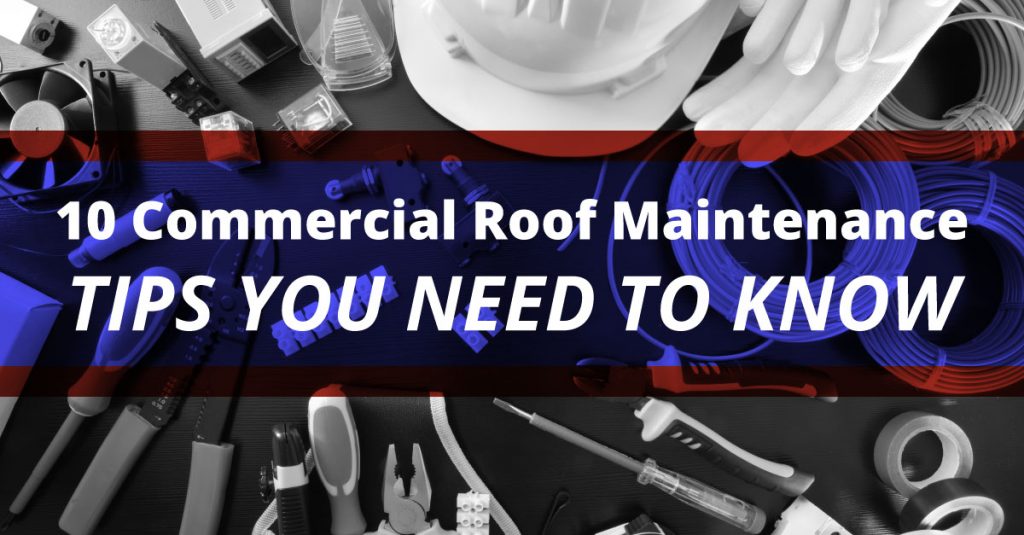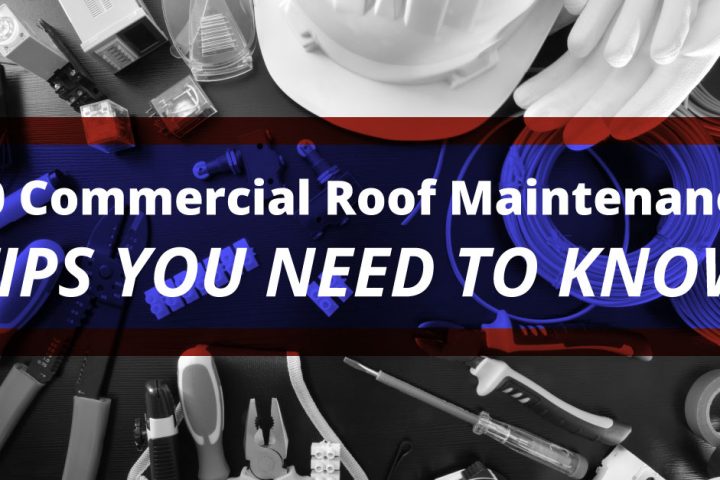
Managing your commercial building can be a challenge. You must negotiate leases, collect rent, schedule cleaning, oversee maintenance and repairs, and resolve unexpected issues.
Your roofing system is among the most critical components of your building’s safety and structural integrity. While addressing issues as they arise is crucial to avoid more costly damage, how can you be certain that you don’t overlook something during commercial roofing maintenance or an annual inspection? Consider the following when inspecting the roof.
Bonus: Check out our free Commercial Roof Maintenance Tips Checklist today to help you keep track of your maintenance needs.
What to Consider When Inspecting Your Roof System
Regular building inspections are part of your job as a commercial property owner or manager. Regarding roofing issues, there are some warning signs that your roof may require repairs or replacement.
Here are 10 commercial roof maintenance tips to be aware of when inspecting your roofing system, including general tips and signs of potential roofing issues inside and outside your building.
1. Keep Maintenance Logs
Having a record of roof maintenance activity and repairs can be invaluable. A maintenance log is a good management tool that’s useful when making repairs or even selling your property.
In your log, record who went on the roof, when they were on the roof (date and time), where they went, and why they were there (maintenance, inspection, repair, etc.).
2. Record Everything You Encounter During Your Inspection
Record the state of every item you look at—vents, flashing, etc. Determine whether they’re in good condition or need repairs. Take pictures and document any damage for future reference, as you may also need to make an insurance claim.
3. Create a Custom Toolkit
Create a toolkit with everything you need to inspect your roof. Include a checklist, roof plans, aerial photos, pencil and paper for jotting down notes, a camera to take pictures of damage, a tape measure, and a flashlight.
4. Check the Walls
When inspecting the interior of the building, check the walls. Look for cracks, mold, peeling or wet paint, and other damage. These issues are often signs of leaks or excessive moisture in the building. Inspect the areas and test them as soon as possible.
5. Check Vents and Chimneys
Inspect all areas around vents and chimneys for dampness. You may find that the flashing has broken down and needs replacement or repair.
6. Check Your Attic
Is there sufficient ventilation in the attic? Is there visible damage to the decking or cracks in the rafters and sheathing? Is light shining through the roof where it shouldn’t? These are all visible signs of potential damage that, if not addressed immediately, can lead to extensive and costly repairs.
7. Check for Leaks
Also, check for visible leaks and their location. You should address leaks quickly. A leak can lead to rot, mold, or structural damage if left unrepaired. Take pictures to document leak locations, and call a professional roofer for an inspection.
8. Check for Visible Damage
Look for apparent damage and large debris blocking your roof’s drainage system. Are there obvious signs of damage? Check for blocked or broken gutters and downspouts. Your roofer can take care of these issues to help prevent future damage.
9. Wear and Tear
Check all flashing, vents, chimneys, fascias, drip edges, and decking. Look to see if the roof is sagging, corroded, rotting, or missing parts. If any of these issues are present, contact your roofing professional.
10. Check These Extras on a Flat Roof
Look for ponding, punctures, holes, blisters, or anything that may have pulled away from the roof.
Essential Commercial Roof Maintenance Tips
After a successful inspection, you’ll need to conduct routine maintenance to keep the roofing system in good condition for many years. Here are some tips for commercial roof maintenance.
1. Limit Its Load
Although your commercial roof is designed to be sturdy, it has its limitations. Reduce the load on your roof to keep it in good shape. Keep people off the roof unless absolutely necessary, and limit how much you walk on it to reduce the weight it must support.
2. Keep It Clean
Flat commercial roofs are especially susceptible to accumulating debris and dirt. Piles of natural debris like twigs and leaves can trap moisture and encourage mold growth. Mold and decay can deteriorate your roof and weaken its structure. Set a regular cleaning schedule to remove these hot spots early.
3. Unclog Gutters
Clogged gutters and drains can cause water damage to your commercial roofing, threatening its structural integrity. Moreover, unmaintained gutters create a breeding ground for mold and mildew to thrive. To prevent issues, clean it, keep it free from clogs, and regularly inspect for damaged or loose components.
4. Prune Nearby Trees
Falling tree limbs and branches from a storm may cause significant damage to the structure of your commercial roof. Trim nearby trees and shrubs to prevent impact damage and leaf and debris accumulation.
5. Adhere to a Commercial Roof Maintenance Schedule
Experts recommend a roof inspection at least once every six months to identify any underlying issues that need attention. At Roof Repair Specialist, we carefully inspect for undetected leaks, sagging, cracks, and other issues. Timely commercial roofing repair can significantly extend the life of the roofing system.
What Type of Roof Is Used for Commercial Buildings?
Business owners across Burbank, Pasadena, and Los Angeles, CA, can choose among several commercial roofing systems. Various materials make up these roofs, and each type fits specific needs, building requirements, and budgets. But, more importantly, the roofing type determines the proper commercial roof maintenance required to preserve its original shape for the years to come.
1. Metal Roofing
Metal is one of the most durable commercial roofing options, featuring robust fire resistance ratings and strong material. It’s typically made from corrugated galvanized steel, copper, aluminum, tile sheets, or lead. Modern metal roofing comes with protective surface layers to withstand exposure to the elements and resist corrosion.
2. Built-up Roofing Membrane (BUR)
This commercial roofing features layers of tar and gravel, known for its cost-effectiveness and UV-resistant properties. Because it comes in layers, commercial building managers can adjust the number of piles used to achieve the desired level of durability.
3. Modified Bitumen (MB)
Modified Bitumen is an asphalt-based roofing system often used in flat and low-slope commercial roofs. The material features a combination of asphalt, rubber, and fiberglass for added flexibility.
4. Thermoplastic PVC and TPO Roof Membranes
Thermoplastic polyolefin (TPO) and polyvinyl chloride (PVC) are known for being lightweight and puncture-resistant commercial roofing options. They also have excellent weathering and high-temperature tolerance.
5. Ethylene Propylene Diene Terpolymer (EPDM)
EPDM is made of synthetic rubber composed of natural gas and oil and is popular for its elasticity and toughness. It effectively resists UV rays and is more affordable than other commercial roofing alternatives.
6. Shingles
Although more commonly used in residential properties, some commercial establishments incorporate shingle roofing to boost their building’s curb appeal. This roofing material comes in different varieties, like asphalt, slate, plastic, and ceramic.
What Is the Lifespan of a Commercial Roof?
Several factors can influence the average lifespan of a commercial roof, including the material used, whether it received adequate commercial roof maintenance, and the weather conditions in your location. We’ve covered a detailed guide on the expected lifespan of each type of commercial roofing material that you can review. Generally speaking, they can last anywhere from 10 to 60 years.
The following factors also play a significant role in how long your commercial roofing lasts:
- Installation: Flaws in the installation process can shorten the lifespan of any roof. At Roof Repair Specialist, we handle every part of the installation with the utmost care and detail to ensure you get the best value for your money.
- Commercial Roof Maintenance: Routine maintenance, inspections, and timely commercial roof repairs prevent minor problems from turning into irreversible damage.
- Slope: Flat roofing systems are generally more susceptible to water pooling, and leakage is usually the first indicator of this issue.
- Weather: California business owners face intense summer heat, high winter humidity, and strong winds that can damage shingles and other types of roofing systems.
As the building owner or manager, you should have a roofing professional inspect your property every spring and fall. They can address any uncovered problems and advise you on deeper issues you may not have spotted.
If you have any questions or find issues that need immediate attention, the best solution is to contact a roofing professional. If you live in the greater Pasadena, Burbank, or Los Angeles, California area, connect with the commercial roofing experts at Roof Repair Specialist.





